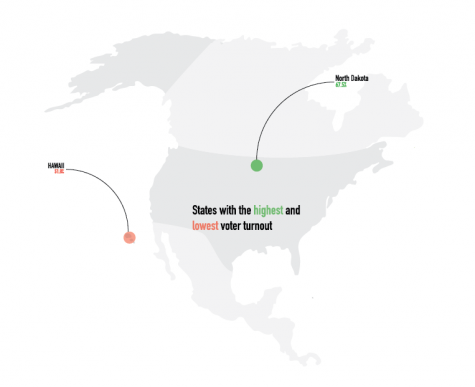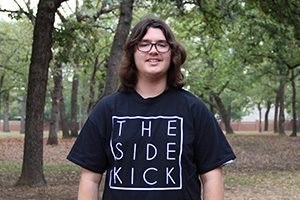Young adults, early voting, and their impact on the upcoming election
February 19, 2016
As the presidential race gains momentum, young voices are arguably becoming the deciding factor in the upcoming elections. With the Iowa Caucuses yielding surprising results on both the Democratic and Republican sides, and record breaking voter turnout lead by young people in New Hampshire, the upcoming election is shaping up to be very interesting.
With this influx of young voters, the mentality of American voters is turning from establishment politics to fresh, new faces with new ideas.
Despite the push for a new style of American politics, many controversial voting traditions remain in place for this election. Probably the most prominent one is the order in which states vote. In recent elections, the Iowa Caucuses have been a week before New Hampshire gets to vote. New Hampshire, however, became the first state to vote in 1920. It wasn’t until 1972 when the number of primaries doubled that New Hampshire became an important indicator of possible election results.
In 1968, the state party chairman of Iowa wanted to ensure that every delegate had a copy of the rules and platform proposals, so the caucuses were moved up to January. The parties agreed to the same date in the 1976 elections, and the tradition has withheld since.
While these states, especially New Hampshire, have historically been accurate representations of possible election outcomes in the past, there is some controversy as to why they should be able to go first. Iowa for example isn’t exactly the most accurate representation of the demographics of America. The state is comprised of 93.9 percent whites, compared to just 2.1 percent African Americans. The state is also 77 percent Christian. Many argue that candidates who might not appeal to Iowa voters, after not doing well in Iowa, might lose support in other states that wouldn’t be lost had they not had to race in Iowa first.
This is a bigger deal than it might seem, because for voters who aren’t constantly tuned into the news, a candidate losing Iowa might make voters in Texas lose faith in their candidate. After all, if they can’t win a small state like Iowa, how are they going to tackle Texas? Other early voting states such as South Carolina and Nevada are a better representation of America demographically, but those come well after Iowa when many candidates at that point would be forced to drop out, either due to low polling, money, or both.
One item that both parties will agree on is that a high voter turnout is a huge advantage for nearly every candidate in its own

way. Since 1980, Hawaii has had the lowest voter turnout with only half (51.8 percent) of its residents participating in presidential elections, while Minnesota leads the pack with 73.2 percent of residents voting in elections. History also tells us that young adults are the least likely to get out and vote.
Here in Texas, we are on the low end of the spectrum, with only 56.1 percent of residents participating in elections. Texas has been a conservative state since the 1960s and there is a relationship between voter turnout and political affiliation. Historically, when voter turnout is low, Republicans have won office.
But the world is different today. Today’s generation is more independent, more open minded, and yet more skeptical of politics (as usual) at the same time. It’s no secret that certain career politicians and establishment candidates have been struggling to keep up with the new wave of young adults who are ready for new style of American politics.
In what should have been an easy race for former Secretary of State Hillary Clinton, she has seen the majority of young Democratic support go to her rival, Senator Bernie Sanders. Now this is where voter turnout comes into play. Many of these young Sanders supporters likely wouldn’t have even participated in the upcoming election before Sanders came along.
Likewise on the Republican side, establishment candidates, like Jeb Bush who was predicted to be a front-runner, have been struggling to keep up with businessman Donald Trump in the polls.
While policy wise Trump and Sanders may not be similar at all, the surging popularity of both candidates is very telling of how the majority of American citizens currently feel about how our government is run. Because of these candidates we are seeing establishment candidate Hillary Clinton calling out the big banks, which she never would have done before Sanders became a threat. Meanwhile you have establishment candidates like Rubio and Cruz trying to hop on the grassroots bandwagon on the Republican side.
So what does all of this really mean? It is pretty simple. If young voters end up repeating history and stay home on election night, we are more likely to see an establishment candidate do well (especially in the Democratic party). On the other hand, if young voters turn out in the record numbers that they potentially could, we could see a repeat of 2008 where then-Senator Obama ended up defeating Hillary Clinton thanks to his grassroots support, especially from young people.
Seniors this year will get our first shot to make a difference in American politics. In Texas, early voting opened on Tuesday and runs through Feb. 26, and primary election day is March 1 (you can see if you are registered to vote here.) If you won’t turn 18 until later this year, you can still vote in the general election, which happens in November. The deadline to register is October 11. I feel that young adults really could be the deciding factor in this election, and it is important that everyone exercises their right to vote.










jeff henderson • May 25, 2016 at 4:57 pm
This is a thorough, well written article. Blue ribbon caliber.